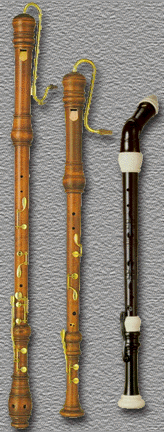 This modern recorder is made from tough
This modern recorder is made from tough
ABS resin. The bag to protect it is made of
vinyl and the cleaning rod is likely made of
polypropylene. |
It looks like a flute, but it's not. It's a recorder, one of the oldest members of the flute family. It dates back to the Renaissance and before. It works a lot like a modern flute, but air is blown through it and not across it.
Recorders were and still are made of wood (a few were even made from ivory - a type of protein). But now less costly plastic recorders are made. These are good for young students and non-professional players. Despite this, they are not toys just because they are plastic. In fact, many of them are precision instruments with a high quality sound. These plastic recorders are made from tough ABS resin, the same polymer used in car bumpers. This makes the recorder less subject to damage and wear. The plastic recorders may even be submerged in water for cleaning.
 This little wood recorder is actually
This little wood recorder is actually
pretty affordable for someone getting
started, but it will require special care. |
Though a wood recorder has an even nicer sound, since wood is a natural polymer, namely cellulose, it is also much more in need of care. NO WATER ALLOWED! A wood recorder must be oiled on the inside to protect it from moisture, which can damage the wood and cause it to dry out and crack. It is also good to warm it up in one's hands before playing it. If the whole instrument is one temperature inside and out before it is played there is less accumulation of moisture and less stress on the wood. The joints of a wood recorder are where the pieces of the body are put together. They are made of soft cork - another form of cellulose - and must be treated with cork grease. A plastic recorder also needs an oil called "recorder cream" - a petroleum product much like Vaseline - on the joints so that it may be more easily put together and taken apart, and so the joints will seal properly. Oils and lubricants such as these can be made from natural or synthetic polymers
 The bass and tenor recorders are so long that they have keys to cover the holes! The plastic bass has a bent neck for easier playing
The bass and tenor recorders are so long that they have keys to cover the holes! The plastic bass has a bent neck for easier playing |
Recorders come in a surprising variety of sizes, from tiny sopranino to massive bass and great bass. The larger instruments have plastic or metal keys and pads to cover the holes, which are too far apart to cover with the fingers. The keys operate much like those of an oboe or clarinet. And the pads that cover the holes are generally made from some sort of leather or kidskin, which are both proteins.
The recorder is often taught to school children because it is a relatively easy instrument to get started on, but it is not a "kid's instrument." There is a great deal of difficult and complex music written for the recorder since it was around before the modern transverse flute. And the high quality wooden recorders played by professionals have a soft warm sound that is unmatched by plastic instruments. These recorders can cost thousands of dollars. So which is better - wood or plastic?



 The bass and tenor recorders are so long that they have keys to cover the holes! The plastic bass has a bent neck for easier playing
The bass and tenor recorders are so long that they have keys to cover the holes! The plastic bass has a bent neck for easier playing